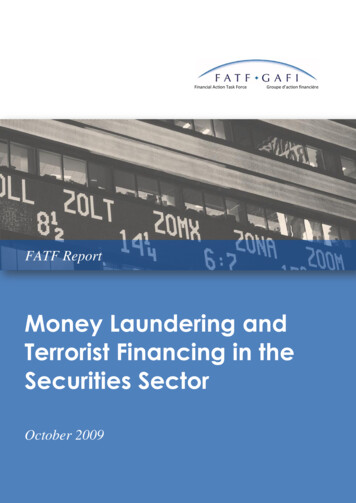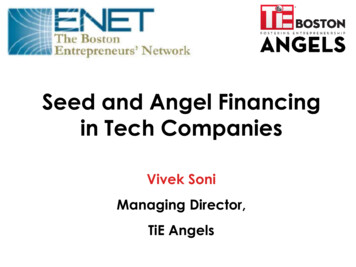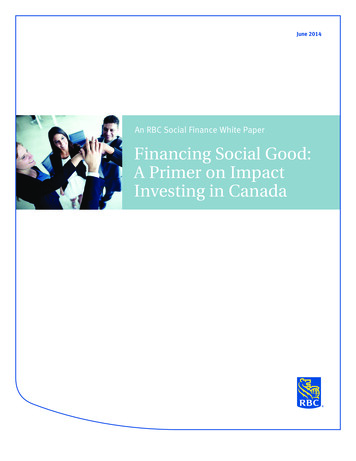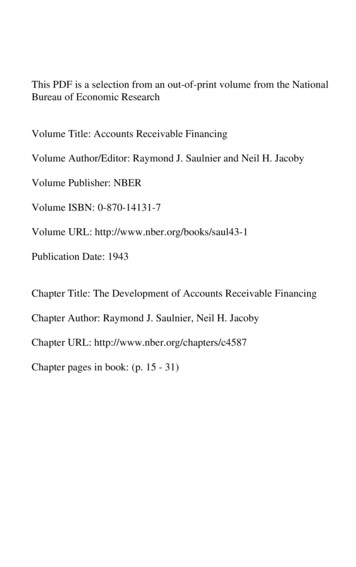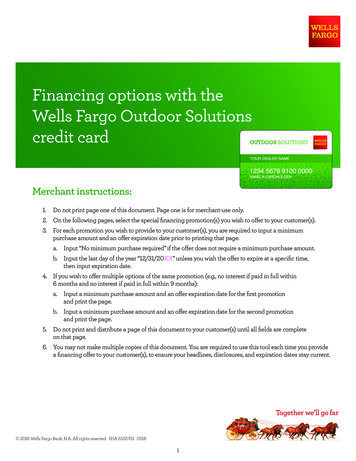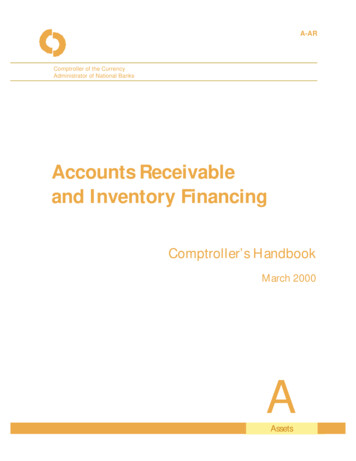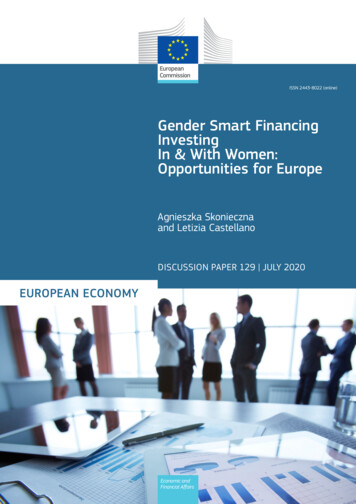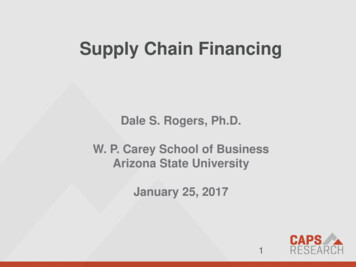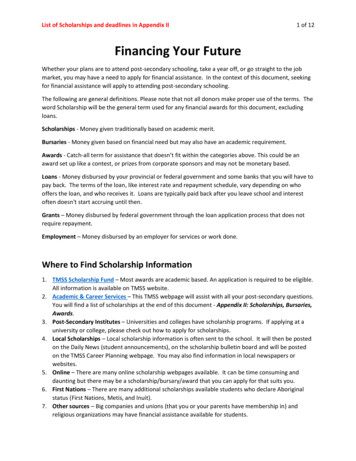
Transcription
Financing the Next Wave ofAfrican InnovationAddressing Critical Funding Gaps forEast African Technology EntrepreneursCONFERENCE COPYApril 30, 2013
AcknowledgmentsThis study, “Financing the Next Wave of African Innovation: Addressing Critical Funding Gaps forEast African Technology Entrepreneurs,” was commissioned by infoDev, a global technologyand innovation program at the World Bank. The study was carried out under the supervision ofOltac Unsal and Ravi Gupta of infoDev, and prepared by Economisti Associati.The main text was written by Roberto Zavatta (Sections 1, 2 and 5) and Enrico Giannotti(Sections 3 and 4), while the annexes were prepared by Elettra Legovini. Prof. Fikremarkos Mersoprovided support for the analysis of legal aspects of the operations of investment funds inEthiopia. Research assistance was provided by Giulia Stecchi and Elisabetta Rizzoli, whilediagrams and maps were developed by Dario Ingiusto, of Mapping the World. Tommaso Grassiand Alberto Bolognini were responsible for quality assurance.More than 100 people including entrepreneurs, business incubator managers, investment fundstaff, banks and other financial institutions, and development professionals gave input for thisstudy. The authors wish to express their gratitude for the valuable information and suggestionsprovided.The study benefited from the comments provided by a group of experts who participated in thepeer review process. The peer reviewers include: Ben White, Founder, Venture Capital for Africa;Britt Gwinner, Principal Operations Officer, IFC; Christian Motzfeldt, CEO, Danish Growth Fund;Eliza Erikson, Director, Investments, Omidyar Network; Mwangi Kimenyi, Director, Africa GrowthInitiative, Brookings Institution; and Shanthi Divakaran, Program Officer, Non-Bank FinancialInstitutions, the World Bank.
DisclaimerThe findings, interpretations, and conclusions expressed herein are entirely those of the author(s)and do not necessarily reflect the view of infoDev, its donors, the International Bank forReconstruction and Development/The World Bank and its affiliated organizations, the Board ofExecutive Directors of the World Bank or the governments they represent. The World Bankcannot guarantee the accuracy of the data included in this work. The boundaries, colours,denominations and other information shown on any map in this work do not imply any judgmenton the part of the World Bank of the legal status of any territory or the endorsement oracceptance of such boundaries.NOTE: All dollar amounts are U.S. dollars unless otherwise indicated.
EXECUTIVE SUMMARYAccess to finance is generally regarded as a major impediment to the development of micro-,small- and medium-sized enterprises (MSMEs) in the East African region. The problem is perceivedto be particularly severe in the case of innovative firms. The purpose of this study is to shed lighton the magnitude and severity of the financing gap faced by innovative MSMEs and toformulate recommendations for operational measures that could alleviate the constraintsidentified. The study covers four countries: Ethiopia, Rwanda, Tanzania and Uganda. It focuseson innovative ventures active in three lines of business (sectors): (i) information andcommunication technologies (ICT), including IT-enabled services such as business processoutsourcing; (ii) climate technology (off-grid power systems, biofuels, etc.); and (iii) innovativeagribusiness activities (producers and distributors of agricultural input, agricultural processors,etc.)Focus of the StudyKey FindingsSources of Financing for Innovative Firms. There are 21 investment funds currently operating (orabout to start operating) in at least one of the four countries. The size of these funds ranges fromas little as 1 million up to 170 million. Investment funds provide risk capital (in the form of equity,loans and quasi-equity instruments) to firms operating in a variety of sectors. Activities in ICT,agribusiness and climate technologies attract a considerable share of investments. However,the focus is on investments in the growth stage, with a preference for deals worth 500,000 orabove. Only one third of the funds focus on smaller deals (i.e., below 200,000) and even feweractively consider early-stage ventures. Commercial banks display a growing interest in workingwith MSMEs. Lending levels are still limited (especially in Rwanda and Ethiopia), but definitely onthe rise. Lending to MSMEs is increasingly supported by a series of credit guarantee schemes andby the availability of IFI/donor-funded credit lines. However, problems persist in the financing ofnewly established ventures, as very few banks will lend to businesses without any track record.Commercial sources of finance are complemented by a variety of grant schemes. A number ofEast African firms have benefited from grant funding, especially in climate technologies andagribusiness, where grants are sometimes quite substantial (from 100,000 to 1 million).
However, in many instances grant funding has been provided without much linkage with othersources of funding, thereby reducing its impact.Financial Sector OverviewFeatures of East African Investment FundsYear ofLaunchFund Size(US million)Acumen Fund200169African Agricultural Capital Fund201125African Seed Investment Fund200912BPI Rwanda SME Fund20118Damascus Capital Growth Fund201330Empact Growth Fund201350eVentures Africa Fund2010.Investment FundRegional Presence and StatusGlobal fund. Regional office in Kenya and also active inUganda, Rwanda and Tanzania. OperationalFund based in Uganda, but active across the whole EastAfrican region. OperationalFund based in Uganda, but active across the whole EastAfrican region. OperationalFund focusing on Rwanda, managed by South Africa’sBusiness Partners. OperationalFund focusing on Uganda. Currently fundraising, expectedto be launched during 2013.Fund focusing on Ethiopia. Currently fundraising, withclosing expected for fourth quarter 2013.Pan African fund, with regional office in Kenya but alsoconsidering deals in other East African countries.
OperationalFanisi Venture Capital Fund201050Fusion African Access2011150Grassroots Business Fund200847GroFin Africa Fund2008170Innovation Catalyst Fund20135InReturn East Africa Fund200925LGT Venture Philanthropy2007.Mango Fund20081Persistent Energy Partners20125Prometheus201465Rift Valley SME Fund 1201360Savannah Fund201210Schulze Global Ethiopia Growthand Transformation Fund2012100TBL Mirror Fund 2201350Stage of Financing and Typical Deal SizeEast African regional fund, with office in Kenya but alsoactive in Uganda, Rwanda and Tanzania. OperationalEast African regional fund, with office in Kenya but alsoactive in Uganda, Rwanda and Tanzania. OperationalGlobal fund, with office in Kenya but also active inTanzania. OperationalPan African fund, managed by South Africa’s GroFin.Offices in Rwanda, Uganda and Tanzania. OperationalFund focusing on Ethiopia. Currently in the process ofbeing set up, with launch expected during 2013East African regional fund, with offices in Kenya andTanzania and also active in Uganda. OperationalGlobal fund, with office in Uganda and also active inTanzania and Ethiopia. OperationalImpact fund, focusing on Uganda. OperationalPan African fund, with office in Tanzania and active inUganda. OperationalPan African fund, but with strong focus on Uganda,Tanzania, Rwanda and Kenya. Currently fundraising, withfirst closing expected in early 2013East African regional fund, with focus on Ethiopia andUganda. Currently fundraising, with first closing expectedin March 2013Pan African fund, but with strong focus on East Africa(Kenya and Tanzania). Already operational but still in theprocess of raising fundsFund focusing on Ethiopia, managed by Singapore-basedSchulze Global. Already operational but still raising fundsEast African regional fund, with office in Kenya. Currentlyfundraising, with first closing expected in September 2013
Features of East African BanksTotal Assets(US million)Loan Portfolio(US million)6,5364,323Dashen Bank (Ethiopia)840455Zemen Bank (Ethiopia)8937Bank of Kigali (Rwanda)472201Banque Rwandaise de Développement(Rwanda)142108FINA Bank (Rwanda)2012Access Bank (Tanzania)33191,682903Commercial bank, owned by DFI, pensionfunds and private investorsTanzanian Investment Bank (Tanzania)193115Development bank, fully state-ownedCentenary Bank (Uganda)378209Microfinance bank, owned by catholicorganizationsDFCU Bank (Uganda)381197Commercial bank, majority owned by DFIUganda Development Bank (Uganda)51.FINA Bank (Rwanda)2012Access Bank (Tanzania)33191,682903Tanzanian Investment Bank (Tanzania)193115Development bank, fully state-ownedCentenary Bank (Uganda)378209Microfinance bank, owned by catholicorganizationsDFCU Bank (Uganda)381197Commercial bank, majority owned by DFIUganda Development Bank (Uganda)51.Bank (Country)Commercial Bank of Ethiopia (Ethiopia)CRDB Bank (Tanzania)CRDB Bank (Tanzania)Nature and OwnershipCommercial bank, fully state-ownedCommercial bank, owned by national privateinvestorsCommercial bank, owned by national privateinvestorsCommercial bank, majority owned by thestate and social security fundDevelopment bank, majority owned by thestate and social security fund, with DFIparticipationCommercial bank, controlled by foreigninterests (Kenya)Microfinance bank, controlled by foreigninterests (Germany), with IFI/DFI participationDevelopment bank, fully state-ownedCommercial bank, controlled by foreigninterests (Kenya)Microfinance bank, controlled by foreigninterests (Germany), with IFI/DFI participationCommercial bank, owned by DFI, pensionfunds and private investorsDevelopment bank, fully state-owned
Recently Approved IFI/Donor Initiatives in Support of MSME Lending
Funding Available through Grant Schemes
Sources of Funding – Pre and Post Revenue Financing
Financing Needs Voiced by Innovative Ventures. The scale of financing needs voiced byinnovative firms varies considerably. The amounts sought by ICT ventures are comparatively low:At the seed stage, new software/web development ventures usually do not need more than 10,000. Funding requirements obviously increase as ICT ventures move beyond the initialdevelopment stage, but nonetheless the amounts sought rarely exceed 150,000. In agribusinessand climate technology, typical financing needs tend to be in the 100,000- 300,000 range, butmore complex agricultural processing operations, biogas plants and pico/mini-hydro powerplants require higher investments, from 500,000 upwards. The nature of financing needs alsovaries. In the case of software/web development ventures and of certain support activities inagribusiness (e.g., certification bodies), funding is mostly required for intangible investments(product development, hiring of expertise, etc.) Funding for working capital is important for thedistributors and installers of home energy devices (solar lamps and lanterns, solar home systems,etc.), while in agricultural processing, financing for the production of biofuels and mini-gridschemes is mostly for investment in fixed assets.Regional Overview of Target Sectors
Typical Financing Needs in ICT sectorTypical Financing Needs in Innovative Agribusiness Sector
Typical Financing Needs in Climate Technology SectorExtent and Severity of the Financing Gap. Evidence suggests the existence of a financing gap fortransactions worth up to 500,000, with more severe problems for ventures seeking up to 100,000. Problems in accessing finance are much less severe for transactions exceeding the 500,000 benchmark. Financing needs above this level are typically voiced by enterprises thathave already been in operation for some time, and there are several sources of funding thatcan be tapped. Obviously a positive reply is not guaranteed, but the problems experienced aredue more to the specific nature of the deals (some initiatives may not be worth financing) thanto structural constraints. The financing gap is more severe in the ICT sector, as the amountssought by innovative ICT firms are typically too small to constitute an attractive proposition forinvestment funds and most banks regard new ventures as too risky. The problem is less acute inthe case of agribusiness and climate technologies, where the volume of potentially accessibleresources is much greater (with several sizeable IFI/donor-funded credit lines and grantschemes) and offers are more aligned with needs. Still, access to funding is far from guaranteed,especially in some emerging lines of business (e.g., biogas plants).
Financing Gap by Sector
Financing Gap by Country
Possible Measures to Alleviate the Financing GapThe diversified nature of financing requirements voiced by innovative firms suggests theadoption of a differentiated approach. In the case of financing needs characterized by astrong intangible investment component, risk capital interventions are the most appropriatesolution. Financing needs associated with working capital requirements and/or investments infixed assets are in principle better served by debt financing instruments. In the case of very smallfinancing requirements, i.e., up to about 20,000, recourse to grant funding appears to be themost advisable solution, although some synergies with other financial instruments can beenvisaged. Based on the above, four options for interventions are possible: two in the area of riskcapital, one targeted at facilitating bank lending, and one squarely addressing the financingneeds of ventures at the seed stage.The first option for increasing the volume of risk capital would involve setting up a dedicatedearly stage investment fund. The fund would focus primarily on deals in the 50,000– 200,000range, with the possibility of larger investments (up to 500,000). The fund could be structured atthe regional level, but would require a local presence in all the countries, either directly orindirectly. Given capital of about 10 million to be invested over a period of five years, the fundcould handle a total of some 50 investments, with an average size of about 150,000 perinvestment. The inevitable complexity of making multiple small investments and the need toensure a strong presence on the ground would entail significant administrative costs, estimatedat some 2 million.As an alternative to a dedicated new fund, it may be possible to cooperate with otherinvestment funds in order to re-orient their activities towards smaller investments. One possibilitywould be to invest in some funds that are at the fundraising stage, with a view to influencing thedefinition of their investment policy. A second possibility would be to set up a technicalassistance facility that could cover the higher costs incurred by investment funds in the case ofnon-mainstream deals (i.e., deals below the usual thresholds). The scale of this option variesdepending upon a variety of factors. In general, in order to have reasonable influence on theoperations of an investment fund, an equity contribution of at least 2 million should beconsidered, while a technical assistance facility assisting five investment funds would requireabout 1.5 million.Facilitation of bank lending could be achieved through the establishment of a credit guaranteemechanism aimed at encouraging banks to consider financial transactions beyond their usualcomfort zone. This could involve the creation of dedicated “innovation windows” within existingcredit guarantee schemes or the establishment of guarantee facilities hosted by businessincubators and specifically targeted at supporting incubatees upon graduation. Creditguarantee schemes are typically highly cost effective, and even modest allocations couldachieve a significant impact (e.g., a 3 million facility could easily support lending worth up to 18 million, assisting 90 firms to borrow an average of 200,000 each).Finally, the financing needs voiced by innovative ventures at the seed stage could beaddressed through a grant scheme that would provide grants in the 10,000 to 20,000 range. Itsmanagement could be entrusted to business incubators and similar support structures. Unlikemost existing grant schemes, which operate in isolation, the seed-grant scheme would involvecollaboration with banks or other financial intermediaries, so that grant money could be used toleverage additional financing. Based on the experience of a recent World Bank initiative in
Ethiopia, grant facility of 2 million (to be distributed among half a dozen incubators) could helpraise an additional 4 million, which would benefit some 130 new ventures.Features of Proposed OptionsOptionsGapResourcesLeverageAddressed NeededMSMEAssisted#1 - New early stagefundUS 50 –200KUS 10million2 times50#2A - Investing inexisting fundsUS 150 –500KUS 2million3 – 5 times15 - 20US 1.5million5 times30US 3million6 times90US 2million2 times80US 2million2 times130#2B - InfluencingUS 100 –operations of existing300Kfunds#3A - CooperationUS 50 –with existing CGS400K#3B - Guaranteefacilities withUS 100K Incubators#4 - Grant schemeUS 20K linked to bank lendingRisks/Challenges High administrative costs (at least 20% of totalbudget, maybe more) Long process for establishment Difficult to involve institutional investors Small pool of funds potentially interested incollaborating Long negotiations to influence investment policy &operations Possible resistance from funds’ general partners(principal – agent problem) Risk of limited utilization due to difficulties in‘objectively’ defining innovative firms Incubator capacity of managing the facility Possibly, long negotiations with banks to agree onterms (depends upon local conditions) Possibly, long negotiations with banks to agree onterms (depends upon local conditions)
Grassroots Business Fund 2008 47 Global fund, with office in Kenya but also active in Tanzania. Operational GroFin Africa Fund 2008 170 Pan African fund, managed by South Africa’s GroFin. Offices in Rwanda, Uganda and Tanzania. Operational Innovation Catalyst Fund 2013 5 Fund
